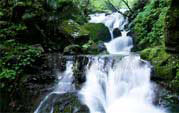Water
Water is essential to all forms of life on earth, yet most of us tend to overlook what an extraordinary substance it is. It is a significant part of most organisms; a potato is 80 percent water, a cow 74 percent, a bacterium 75 percent. Humans are 65 percent, which is the almost the same percentage as that of the earth’s surface. It is one of the few compounds capable of renewing itself. this cycle of circulation and conservation is called the hydrologic cycle.
Most major civilizations were founded on rivers, and an adequate supply is required for all cities and communities. We crave to frolic in it and live beside even though we know it can be dangerous and destructive due to floods, hurricanes and tsunamis.
It has properties not found in any other substances. It contracts when chilled but only down to a point. Once it is close to freezing, it begins to expand to where it is almost a tenth more voluminous as ice than when it was a liquid. Because it expands, ice floats on water. This unique property prevents freezing of lakes and oceans from the bottom up.
Most of us know that water’s chemical formula is H20, which means that is consists of one large oxygen atom with two smaller hydrogen atoms attached to it. The hydrogen atoms cling to their oxygen atoms, but also make casual bonds with other water molecules. A glass of water may not appear to be very lively, but every molecule in it is changing partners billions of times per second. That is why they can stick together to form puddles and lakes but not so tightly that they can’t be easily separated. It also explains how water molecules can flow uphill when siphoned and why water has surface tension. At any given moment, only 15 % of them are actually touching.
The water on earth has been here since the earth was essentially formed. The water you drink may contain molecules that were floating down the Nile during the time of the pharaohs. By 3.8 billion years ago, the oceans had essentially reached their present volumes.
Water exists on earth as a solid (ice), liquid (water) and gas (water vapor). Depending on where it falls, the future for a water molecule varies widely. If it lands on fertile soil, it will be soaked up by plants or evaporated directly within hours or days. If it finds it way down to the groundwater however, it may be there for many years—thousands of years if it migrates to really deep horizons. The water molecules in a lake have been there, on average, about a decade. In the ocean, the residence time is thought to be more like a hundred years. Typically, about 60 percent of water molecules in a rainfall event are returned to the atmosphere in a day or two. Once evaporated, they spend about 10 days in the sky before falling again as rain.
The earth’s oceans are the real powerhouse of the planet’s behavior. Due to water’s amazing capacity for holding and transporting heat, the Gulf Stream carries heat via warm water to Europe and allows Britain and Ireland to have significantly milder winters compared to that of Canada and Russia. This heat transfer loop of the ocean is known as the thermohaline circuit. The warm waters of the ocean flow north to Europe, where they grow colder, become more dense, ink to great depths, and begin a slow trip back to the southern hemisphere. This circuit also helps to stir up nutrients as the currents rise and fall, making greater volumes of ocean habitable for fish and other creatures.
The oceans also responsible for another critical function that makes the earth habitable for most lie; it absorbs a tremendous amount of carbon and provides a means for keeping if safely locked away. Millions of tiny organisms capture and store atmospheric carbon, in the form of carbon dioxide when it falls as rain, and incorporates it into their tiny shells. Carbon dioxide being absorbed by the oceans is one the Earth’s natural defenses against global warming.
Oceans, rivers, clouds and rain are in a constant state of change; however, the amount of water on earth does not change. The water realm is known as the hydrosphere and it is overwhelmingly oceanic. Ninety seven percent of all water on earth is in the seas with more than half of it in the Pacific Ocean alone. Of the 3 percent of water that is considered fresh water (low salt content), most of it exists as ice. Only the tiniest amount, 0.036 percent, is found in lakes, rivers and reservoirs. For comparison, consider that if all of the world’s water was represented as a gallon container, only a teaspoon would be considered fresh water. An even smaller part-just 0.001 percent – exists in clouds or as vapors. Water is so vital to us that it is easy to overlook the fact that all but the smallest fraction is poisonous to us because of the salts within it.
This tiny amount of fresh water that is essential for all human life, for drinking, washing, cleaning, disposal of human wastes, industrial mfg. and production, cooling, heating, growing our food, transportation, dilution and infinite number of other uses, is the raison d’tere for Complete Water Services. Our staff is dedicated to helping the world effectively utilize, manage and conserve this precious resource.

